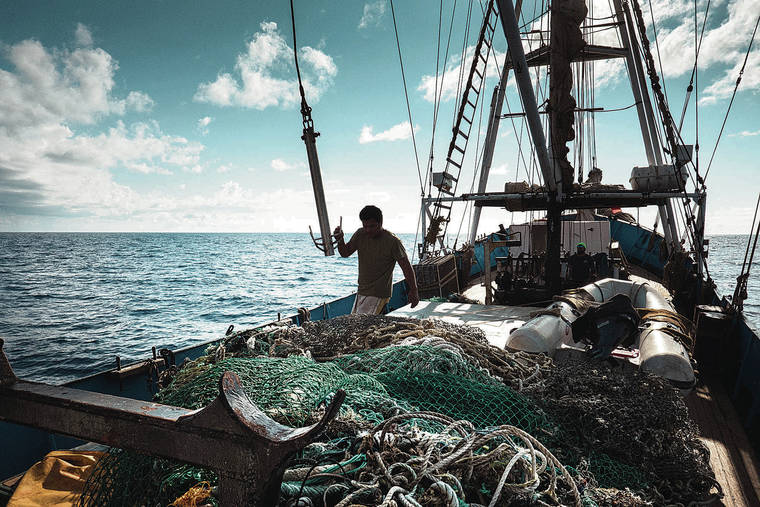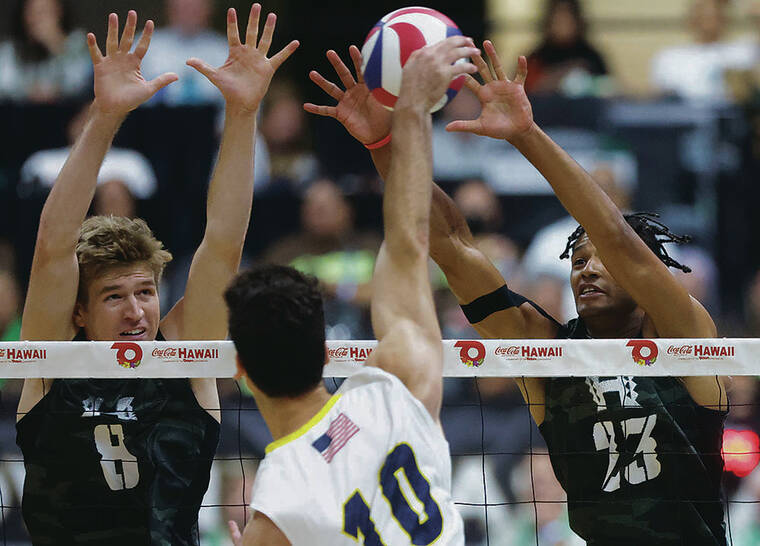Ship returns from Great Pacific Garbage Patch with 67 tons of plastic trash

TODD YAMASHITA / OCEAN VOYAGES INSTITUTE
Deckhand Ieie Teibitoa guides the large hook used for the cargo ship KWAI’s crane to collect marine trash during the Ocean Voyages Institute’s voyage at sea to the Great Pacific Garbage Patch. The vessel has several hooks to pull ghost nets and plastic debris from the ocean.
In the fierce midday sun at Kewalo Basin Harbor Wednesday, elephantine mounds of algae-wrapped, tar-stained, red and yellow cordage, poison-green fishing nets and bleached consumer plastics in various stages of decay were being unloaded from the weatherbeaten hull of the tall-masted cargo ship KWAI, which had returned to Honolulu that morning with its hold bearing 67 tons of marine trash collected from the Great Pacific Garbage Patch during 35 days at sea.
It was the vessel’s second and final open-ocean recovery mission this year for the Ocean Voyages Institute, whose 48-day expedition in May and June had removed a record-setting 103 tons of trash caught in the North Pacific Gyre between Hawaii and California.
In all, the KWAI logged 5,000 nautical miles this summer, and sailed with the wind about 25% of the time, said Brad Ives, senior captain and ship’s owner. “We could have but didn’t sail more because we worked during calm, glassy weather when it’s easier to spot debris.”
Other vessels helped the KWAI locate garbage shoals, he added, by tagging them with GPS trackers provided by OVI.
The total 170 tons recovered was quadruple the amount they’d collected last year, said Mary Crowley, the institute’s executive director, who founded the nonprofit environmental organization in 1979, her blue eyes smiling above her face mask as she sat under a canopy tent, supervising the unloading and sorting of lines, netting, floats, crates, jugs, bottles, and broken bits.
“Next year, our goal is to collect a million pounds of toxic plastics from the sea, to educate people how much is out there and how much more needs to be removed,” said Crowley, who has been conducting OVI cleanup voyages since 2009.
Don't miss out on what's happening!
Stay in touch with breaking news, as it happens, conveniently in your email inbox. It's FREE!
Equally crucial was discovering “what we can do with all these tons of refuse without harming the environment.”
To that end, trucks were pulling up to the trash hills, which were being sorted into different piles for recycling and upcycling as a lift kept hauling more of it out of the hold onto the dock.
The trash will be repurposed in a variety of ways.
Nikolai Maximenko, senior researcher at the Biosciences Research Center in the School of Ocean and Earth Science and Technology at the University of Hawaii at Manoa, was collecting samples for biological research, including some “that we’re sending back to the Smithsonian Institution, one of our partners,” Crowley said, adding that OVI and Maximento’s lab have been collaborating for 11 years.
A California-based company was using the plastics to make building products such as insulation boards, and a European company was upcycling the finer netting into bracelets, necklaces, keychains and more.
Schnitzer Steel was taking currently unredeemable garbage to burn in Oahu’s H-Power plant.
All these partners covered the removal and shipping costs of their portions of the trash, Crowley said, and the institute was dedicated to finding new green uses for all of it, but had to be careful: “We don’t want to create more microplastics when turning plastics into fabric, for instance.”
She also faced a mountain of fundraising. “We’ve used up all our funding, about $350,000 this year,” she said. “We’ll need three ships to meet our million-ton goal in 2021.”
An added challenge this year, she said, was having to quarantine the 11-13 crewmembers for two weeks and make sure they tested negative for the new coronavirus before they sailed.
Asked how she appeared so calm, all things considered, Crowley said, “My calm comes from spending many months and years out at sea.”





